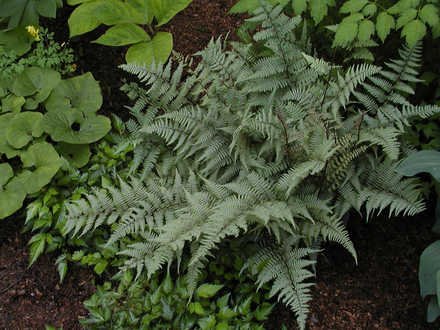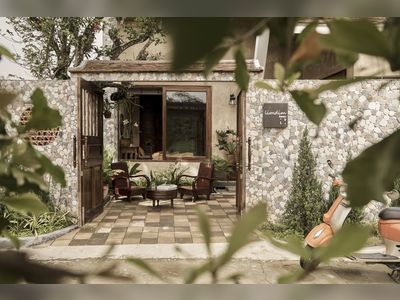Scary characters
Witches and ghosts are well represented in plant names. Common witch hazel (Hamamelis virginiana) is a large native shrub that bears its unusual yellow flowers around Halloween. However, the witch in its name probably is not from the pointy-hatted character but from a Middle English word referring to a plant with flexible branches. On the other hand, witches' brooms, the term used to describe the odd clusters of twiggy growth that sometimes appear on tree branches, definitely refers to a witch's favorite mode of transportation.
Ghostly plant names include: ghost weed (Euphorbia marginata), a variegated native annual better known to most gardeners as snow-in-summer; the cultivar name for a silver-leafed hybrid fern, Athyrium 'Ghost,' and a silver-variegated version of the ground cover dead nettle, Lamium maculatum 'Ghost'.
But the best ghost story is that of a large sea holly (Eryngium giganteum) favored by Ellen Willmott, a widely known gardener in early 20th-century England. She reportedly liked to drop seeds of this plant in friends' gardens. The silvery-white plants would mysteriously appear a year or two later, leading to its common name "Miss Willmott's ghost."
Vampire's delight
Fake blood puts the finishing touch on many a Halloween costume, and blood shows up in plant names, too. The fleshy roots of the native wildflower bloodroot (Sanguinaria canadensis) hold a reddish-orange sap that was once used as a dye. Bloodleaf (Iresine) is a tropical annual with foliage in bright shades of pink, red and orange. The bright red flower buds of the tropical butterflyweed Asclepias curassavica give it the common name blood flower. And the graphic cultivar name 'Bloody Butcher' is used both for a deep purple-red-colored tomato and for an ornamental dry corn with red kernels.
A few other plants have body-part-related names, including the delightfully gross eyeball plant (Spilanthes oleracea), an annual whose oval flowerheads do indeed look like eyeballs on stalks. Liverwort is a primitive, ribbonlike plant that sometimes pops up in damp potting soil in greenhouse plants. And lungwort is the rather unfortunate common name for pulmonaria, a popular shade-tolerant perennial that sports silver-spotted leaves. (Apparently early herbalists thought the spots looked like lung tissue. Ick!)
Creepy crawlers
It wouldn't be Halloween without a few spiders hanging around. While fake spiders are great for scary effect, gardeners know that the real things are terrific garden allies, because they eat many insect pests.
A number of plants include spider in their names. In the case of the easy-to-grow annual known as spider flower (Cleome hassleriana), it refers to the protruding flower stamens and seed pods, which look a bit like long spider legs.
The appearance of its angled leaf joints may explain the spider in spiderwort (Tradescantia spp.), a native plant with blue or purple flowers. Spider also seems an appropriate description for the dangling offshoots of spider plant (Chlorophytum comosum), a popular -- and not at all scary -- houseplant.
Nancy Rose is a horticulturist with the University of Minnesota Extension. To ask her a gardening question, call 612-673-9073 and leave a message. She will answer questions in this column only.



![A Tranquil Jungle House That Incorporates Japanese Ethos [Video]](/images/22/08/b-2ennetkmmnn_t.jpg)







